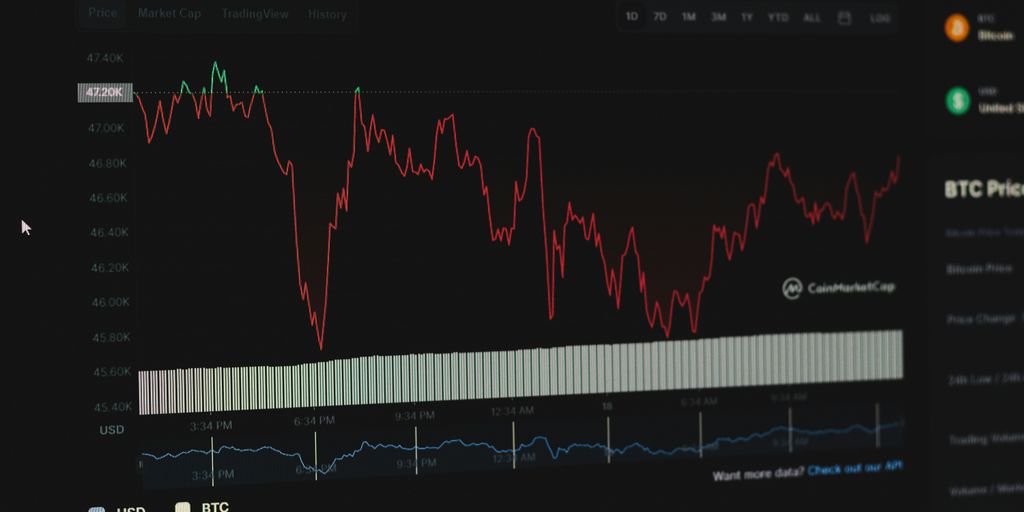Thinking about investing in Grammarly before it hits the public market? It’s a big step, and there’s a lot to consider. Grammarly, the popular writing assistant, has been around for a while, growing steadily. Many people are curious about what it takes to get in on the ground floor, so to speak, before a company like this goes public. This article breaks down what potential investors need to know about the Grammarly IPO, from understanding how these private investments work to what might happen down the road.
Key Takeaways
- Grammarly, a well-known writing tool, is currently a private company, meaning its shares aren’t traded on public stock exchanges like the NYSE or Nasdaq.
- Investing in Grammarly before a potential Initial Public Offering (IPO) is typically limited to accredited and institutional investors, often through specialized secondary market platforms.
- The valuation of private companies like Grammarly isn’t fixed and can be estimated based on past funding rounds and market analysis, but actual figures can vary.
- While the CEO has indicated going public is a goal, there’s no set timeline for the Grammarly IPO, making any investment speculative.
- Exiting an investment in a private company like Grammarly usually involves selling shares on a secondary market or waiting for a liquidity event, such as an IPO or acquisition, which are not guaranteed.
Understanding Grammarly’s Pre-IPO Landscape

Before we get too deep into thinking about buying Grammarly stock, it’s probably a good idea to get a handle on where the company stands right now, in the world of private markets. It’s not like buying shares of Apple or Google, where you just hop on your usual trading app. Investing in companies before they go public, often called pre-IPO investing, is a whole different ballgame. It’s a bit like trying to get a ticket to a really popular concert before it officially goes on sale – you need to know where to look and who to talk to.
Grammarly’s Journey to a Potential IPO
Grammarly started way back in 2009, founded by a few folks from Ukraine. Their initial idea was pretty simple: help students get their grammar and spelling right. Fast forward to today, and it’s a massive AI-powered writing assistant used by millions. They’ve grown from a small startup to a company with a valuation that’s reportedly in the billions, with the last known valuation around $13 billion back in late 2021. This growth trajectory is a big reason why people are talking about a potential IPO. The company has been steadily adding features and expanding its reach, making it a significant player in the productivity software space. It’s a journey that’s seen them raise substantial funding, which is typical for companies aiming for the public markets, much like how Virgin Galactic has pursued its own ambitious goals.
The Role of Pre-IPO Marketplaces
So, how do you even get a peek at Grammarly stock before it’s on the New York Stock Exchange? That’s where pre-IPO marketplaces come in. Think of these as special online spots where people who already own shares in private companies, like Grammarly, can sell them to other investors. It’s not a direct sale from the company itself; rather, it’s like a secondary market for private shares. These platforms are key for investors who want to get in early, but they also come with their own set of rules and risks. You’ll often find that only certain types of investors, usually accredited ones, can even participate.
Navigating Secondary Market Trades
When we talk about secondary market trades for pre-IPO companies like Grammarly, it means shares are changing hands between investors, not being issued by the company. Grammarly itself isn’t getting new money from these trades. It’s more like a private transaction between a seller and a buyer. These deals can be tricky because the terms can vary a lot from one trade to another. Plus, there are often restrictions on who can buy and sell, and when. It’s important to understand that these kinds of investments are generally less liquid than public stocks, meaning it might be harder to sell them quickly if you need to. The information available can also be more limited compared to public companies, so doing your homework is really important.
Grammarly’s Business and Growth Trajectory
Grammarly has really grown from its early days. What started as a simple tool to help students with grammar and spelling has turned into a much bigger operation. They’re now looking at building a whole platform focused on AI-powered productivity, which is a pretty big leap. It’s not just about fixing sentences anymore; they’re aiming to change how we communicate and work overall.
The Evolution of Grammarly’s Product Suite
Grammarly’s core product, the writing assistant, is still the main draw. It checks for grammar, spelling, punctuation, and even things like clarity and tone. But they’ve been expanding beyond just that. Think about integrations with different apps and websites, making it useful wherever you’re typing. They’ve also acquired companies like Superhuman, which focuses on email efficiency, showing they want to offer more tools to help people communicate better and faster. It feels like they’re building a suite of tools, not just one product.
Key Metrics and User Base Expansion
Grammarly has seen some impressive growth. They’ve got tens of millions of daily users, which is a huge number. Financially, they’re doing well too, bringing in over $700 million in annual revenue as of the second quarter of 2025. What’s really interesting is that they’re profitable, which means they haven’t had to rely too heavily on outside money to grow. This kind of steady expansion is often a good sign for potential investors. It shows they have a solid business model that people are willing to pay for.
Grammarly’s Competitive Advantages
So, what makes Grammarly stand out? For starters, their AI technology is pretty advanced. It’s not just catching simple mistakes; it’s understanding context and offering suggestions that actually improve writing. Plus, having such a large and active user base gives them a massive advantage. They get tons of data from all those users, which helps them train their AI to get even better. This creates a bit of a feedback loop: more users mean better AI, and better AI attracts more users. They also have a strong brand name that people recognize and trust for writing assistance. It’s hard for new companies to break into that space once Grammarly has established itself.
Assessing Grammarly’s Valuation and Financials
Figuring out what a company like Grammarly is worth before it goes public can feel a bit like trying to hit a moving target. It’s not just about looking at past sales; you’ve got to consider where the company is headed and what the market is willing to pay. This involves digging into their funding history and understanding how those past investments shape the current picture.
Estimating Grammarly’s Pre-IPO Valuation
When we talk about pre-IPO valuation, we’re essentially looking at what investors believe the company is worth before it starts trading on a public stock exchange. This isn’t a fixed number; it can fluctuate based on market sentiment, the company’s performance, and even news cycles. Think of it as a snapshot of perceived value at a given moment. For Grammarly, this valuation has seen some serious upward movement over the years, reflecting its growing user base and expanding product capabilities. It’s a dynamic figure, and understanding the factors that influence it is key for anyone looking to invest.
Understanding Valuation from Funding Rounds
Grammarly’s journey through various funding rounds gives us a pretty clear roadmap of how its valuation has evolved. Each time the company raises money, it does so at a specific valuation, agreed upon by both the company and its investors. For instance, they raised $90 million in late 2019 at a $1 billion valuation, and then a much larger $200 million in November 2021, which put their valuation at a hefty $13 billion. This kind of data is super helpful because it shows a clear trend of increasing investor confidence and market acceptance. It’s like seeing the price tag go up with each successful step the company takes. You can see this valuation history to get a better sense of the growth.
Factors Influencing Future Valuation
So, what makes a company’s valuation go up or down? For Grammarly, several things are at play. First off, user growth is a big one. The more people using Grammarly, the more valuable it’s perceived to be. Then there’s the product itself – how well it’s doing, if new features are being added, and if it’s keeping up with competitors. The overall health of the tech market and the economy also plays a role. If investors are feeling optimistic, they’re usually willing to pay more. Conversely, if the economy is shaky, valuations might dip. It’s a mix of the company’s own performance and the broader economic environment. Things like expanding into new markets or developing new AI capabilities could also significantly boost its future worth.
The Path to the Grammarly IPO
Factors Dictating the IPO Decision
The decision for Grammarly to go public isn’t just a simple yes or no. It’s a big move that depends on a bunch of things. Think about how the company is doing financially – are sales strong? Is it making money? Then there’s the whole market out there. Is it a good time for companies to start selling shares? Are investors feeling confident? Grammarly also has to consider its own plans. Does going public fit with what they want to achieve long-term? It’s a complex puzzle with many pieces.
CEO’s Perspective on Going Public
Grammarly’s CEO, Shishir Mehrotra, has spoken about the company’s future. He’s mentioned that right now, the focus is on creating new products and growing the business as quickly as possible. He’s indicated that the company will go public when they feel ready. This suggests a thoughtful approach, prioritizing readiness over a specific date. It’s about building a solid foundation before taking that public step.
When Might Grammarly Go Public?
So, when exactly might Grammarly make its debut on the stock market? Honestly, nobody knows for sure unless the company says so. They haven’t put out any official timeline. Any talk about when it might happen is just guesswork. Investors interested in Grammarly should keep an eye on official announcements from the company and trusted financial news sources. If you’re looking to invest and can’t wait, you might explore pre-IPO marketplaces, but remember those come with their own set of risks. For those who prefer a more traditional route, waiting for the IPO means you’ll need a brokerage account, and platforms like Public are often recommended for that. You can find out more about investing in private markets on sites like UpMarket.
Investing in Grammarly Before Public Offering
So, you’re thinking about getting a piece of Grammarly before it hits the big leagues, huh? It’s definitely a hot topic, and for good reason. But jumping into pre-IPO investments isn’t quite like buying stock on the regular market. It’s a bit more involved, and you need to know the lay of the land.
Eligibility for Pre-IPO Investment
First off, not everyone can just buy Grammarly shares right now. Because it’s still a private company, the rules are different. Generally, you need to be an "accredited investor." What does that mean? It usually involves meeting certain income or net worth thresholds. Think high earners or people with significant assets. If you don’t meet those requirements, you might not be able to buy shares directly. However, there are other ways to get exposure, like investing in venture funds that might hold Grammarly stock. It’s a bit like investing in a basket of private companies rather than picking just one.
How to Invest in Grammarly Shares
If you are eligible, how do you actually do it? One common route is through pre-IPO marketplaces. These are platforms where people who already own shares in private companies can sell them to new investors. It’s kind of like a stock exchange, but for private companies. You might also find opportunities through investment syndicates or specialized funds. These secondary market transactions often require working with a registered broker. It’s not as simple as clicking a button on a public trading app. You’ll likely need to go through more paperwork and due diligence. For those interested in the broader private markets, platforms like HelpTheCrowd offer analytics tools that can help you understand investment opportunities in the European equity crowdfunding space, which can give you a feel for this type of investing.
Risks Associated with Private Investments
Now, let’s talk about the not-so-fun stuff: the risks. Investing in private companies like Grammarly before an IPO is generally considered riskier than buying stock in a public company. For starters, information can be harder to come by. You don’t have the same level of public disclosure requirements. Also, these shares are usually illiquid, meaning it can be tough to sell them quickly if you need your money back. There’s also the risk that the company might not go public at all, or that its valuation could drop. Grammarly itself has a say in who buys its shares, too; they often have a right of first refusal, meaning they can buy back shares before they’re sold to someone else. It’s a different ballgame, for sure.
Exiting Your Grammarly Investment
So, you’ve put some money into Grammarly, and now you’re wondering how to get your cash back out. It’s a fair question, especially with private investments.
Potential Exit Strategies for Investors
When you invest in a private company like Grammarly, your exit options aren’t as straightforward as selling stock on a public exchange. The main ways to get your money out usually involve either selling your shares to another investor on a secondary market or waiting for a major company event. The big one everyone hopes for is a liquidity event, which typically means the company goes public through an IPO or gets bought out by another company. The timing and even the possibility of these events are never guaranteed, so it’s important to go in with realistic expectations. You might find buyers on platforms that specialize in pre-IPO shares, but this depends on demand and the company’s policies. It’s also worth noting that Grammarly recently secured a $1 billion non-dilutive growth financing package from General Catalyst’s Customer Value Fund (CVF) [99c1], which could influence its future path and potential exit opportunities.
Understanding Share Transfer Limitations
Before you even think about selling, you need to know that not all shares are created equal, especially in private companies. If you got your shares as part of an employee stock option plan, for instance, there might be rules about when and how you can sell them. Companies often put in place things like lock-up periods, which prevent selling for a certain time after an event, or a right of first refusal, meaning Grammarly itself gets the first chance to buy your shares back before you can sell them to someone else. These restrictions can really affect your ability to cash out when you want to.
The Impact of Liquidity Events
When a company like Grammarly has a liquidity event, it’s usually a big deal for investors. The most common scenario is an Initial Public Offering (IPO), where the company starts trading on a stock exchange. This makes your shares much easier to sell. Another possibility is an acquisition, where another company buys Grammarly outright. In either case, these events can provide a clear path to selling your stake. However, the decision to go public or get acquired is complex, depending on market conditions and the company’s own strategic direction. It’s wise to keep an eye on official company announcements and financial news for any hints about Grammarly’s plans.
Grammarly’s Founding and Leadership
Grammarly didn’t just appear out of nowhere; it was built by a team with a clear vision. The company was started back in 2009 by three software developers from Kyiv, Ukraine: Max Lytvyn, Alex Shevchenko, and Dmytro Lider. Their initial goal was pretty straightforward: help students get better at grammar and spelling. It’s kind of funny how something that started with students in mind has grown into a tool used by millions of people every day, across all sorts of professions.
The Visionaries Behind Grammarly
Max Lytvyn, Alex Shevchenko, and Dmytro Lider are the folks who got the ball rolling. They saw a need for a better way to communicate clearly and set out to build it. It’s impressive that they started this company with a focus on improving communication, which is something everyone can relate to. They really laid the groundwork for what Grammarly is today, focusing on using technology to solve real-world problems. It’s always interesting to look back at the early days of successful companies and see the initial spark.
Key Members of the Management Team
While the founders are key, a company like Grammarly has a whole team steering the ship. Current leadership includes people like CEO Rahul Roy-Chowdhury, who is guiding the company’s strategy. Then there’s Lena Waters, the Chief Marketing Officer, making sure people know what Grammarly can do. Joe Xavier is the Chief Technology Officer, likely overseeing the AI and product development. Other important roles include Chief People Officer Heather Gille and Chief Product Officer Noam Lovinsky. These individuals, along with others, are shaping Grammarly’s future. It’s a pretty solid group, and their combined experience is probably a big reason for the company’s success.
Major Investors Fueling Growth
Grammarly has had some significant backing over the years, which has definitely helped it grow. Big names like Baillie Gifford and BlackRock Inc. have invested, showing confidence in the company’s potential. Other major investors include General Catalyst, Institutional Venture Partners (IVP), and Spark Capital. These firms aren’t just throwing money around; they often bring strategic advice and connections that can really help a company scale. Having these kinds of investors on board is a good sign for anyone looking at Grammarly’s future, especially as it gets ready for a potential IPO. It suggests that experienced players see a lot of promise in what Grammarly is building. You can find more information about how companies are structured and the importance of early legal steps by looking into establishing a technology start-up.
Wrapping Up: What’s Next for Grammarly Investors?
So, that’s the lowdown on Grammarly and its potential path to going public. It’s a company with a big user base and a clear plan to grow, but like any investment, especially in the private market, there are definitely things to keep in mind. The exact timing of an IPO is still up in the air, and getting in before that happens usually means you need to be an accredited investor and navigate some specific marketplaces. If you’re thinking about investing, keep an eye on official company news and be sure you understand all the risks involved. It’s a bit of a waiting game, and things can change, so staying informed is key.
Frequently Asked Questions
What is Grammarly’s stock price?
Grammarly is a private company, so there’s no public stock price yet. You can sometimes find estimates based on how much the company is valued during its private funding rounds. For example, if Grammarly was valued at $10.95 billion and had 250 million shares, each share might be worth about $43.82. But remember, this is just an example, and the actual price could be different.
How do pre-IPO trades for Grammarly work?
Buying Grammarly shares before it goes public usually happens on special online markets. These are called pre-IPO or secondary markets. Think of it like this: people who already own Grammarly shares sell them to new investors. Grammarly itself doesn’t get new money from these trades. It’s a bit risky because it’s not as easy to buy or sell, and you might not have all the same information as you would with a public company.
When is Grammarly planning to go public?
No one knows for sure exactly when Grammarly will go public. The company’s CEO has said they’ll go public when they feel ready and are focused on growing and making new products. It really depends on how well the company is doing and what the overall economy is like. It’s best to keep an eye on official announcements from Grammarly or reliable financial news to find out.
How can I sell my Grammarly shares if I invest early?
If you invest in Grammarly before it’s public, you can usually sell your shares on those special secondary markets to other interested investors. Another way is to wait until something big happens, like the company going public (an IPO) or being bought by another company. However, there’s no guarantee when or if these things will happen, so it might take time to get your money back.
How can I sell Grammarly shares before it becomes a public company?
Selling your Grammarly shares before the company goes public can be tricky. You might be able to sell them on a secondary market if you find a buyer. Sometimes, a broker can help. But, it depends on the type of shares you have. For instance, shares given to employees might have rules that limit when or if you can sell them, like needing the company’s permission first.
Who started Grammarly and what was their original idea?
Grammarly was started in 2009 by three friends who were good at software: Max Lytvyn, Alex Shevchenko, and Dmytro Lider. They were all from Ukraine. Their first idea was to help students fix their grammar and spelling, but it quickly turned into a tool that helps everyone write better by checking grammar, spelling, and even the tone of your writing as you type.














